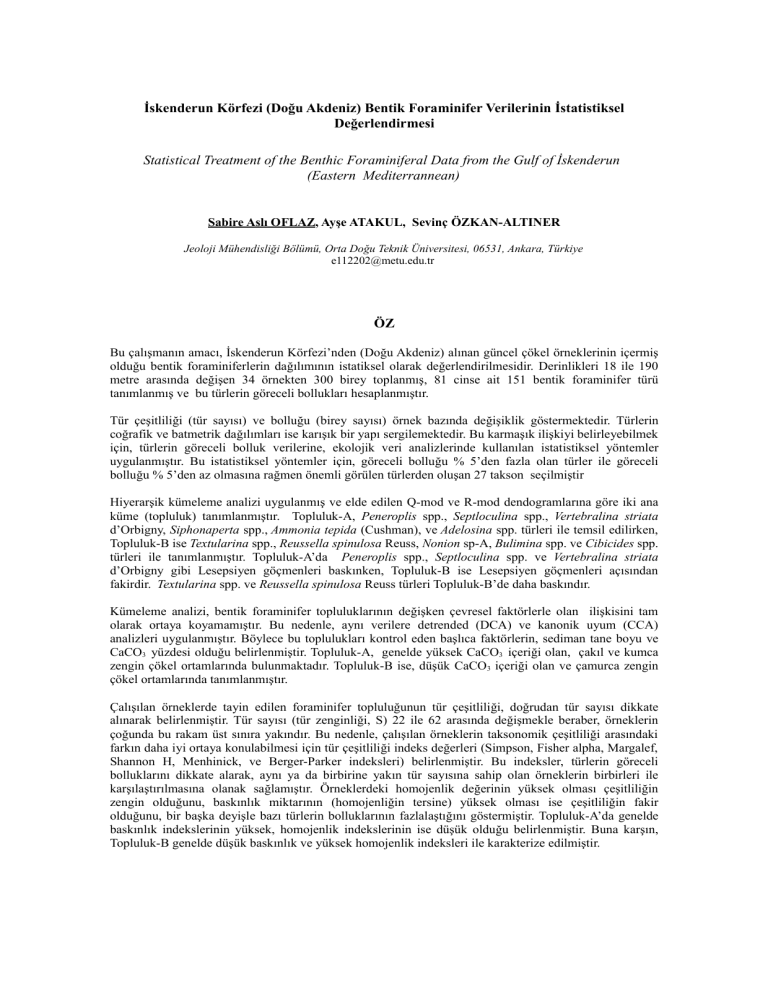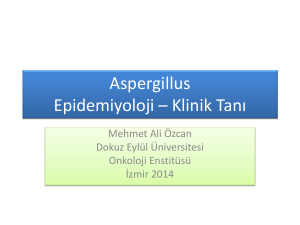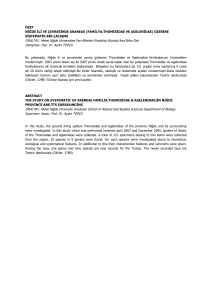
İskenderun Körfezi (Doğu Akdeniz) Bentik Foraminifer Verilerinin İstatistiksel
Değerlendirmesi
Statistical Treatment of the Benthic Foraminiferal Data from the Gulf of İskenderun
(Eastern Mediterrannean)
Sabire Aslı OFLAZ, Ayşe ATAKUL, Sevinç ÖZKAN-ALTINER
Jeoloji Mühendisliği Bölümü, Orta Doğu Teknik Üniversitesi, 06531, Ankara, Türkiye
[email protected]
ÖZ
Bu çalışmanın amacı, İskenderun Körfezi’nden (Doğu Akdeniz) alınan güncel çökel örneklerinin içermiş
olduğu bentik foraminiferlerin dağılımının istatiksel olarak değerlendirilmesidir. Derinlikleri 18 ile 190
metre arasında değişen 34 örnekten 300 birey toplanmış, 81 cinse ait 151 bentik foraminifer türü
tanımlanmış ve bu türlerin göreceli bollukları hesaplanmıştır.
Tür çeşitliliği (tür sayısı) ve bolluğu (birey sayısı) örnek bazında değişiklik göstermektedir. Türlerin
coğrafik ve batmetrik dağılımları ise karışık bir yapı sergilemektedir. Bu karmaşık ilişkiyi belirleyebilmek
için, türlerin göreceli bolluk verilerine, ekolojik veri analizlerinde kullanılan istatistiksel yöntemler
uygulanmıştır. Bu istatistiksel yöntemler için, göreceli bolluğu % 5’den fazla olan türler ile göreceli
bolluğu % 5’den az olmasına rağmen önemli görülen türlerden oluşan 27 takson seçilmiştir
Hiyerarşik kümeleme analizi uygulanmış ve elde edilen Q-mod ve R-mod dendogramlarına göre iki ana
küme (topluluk) tanımlanmıştır. Topluluk-A, Peneroplis spp., Septloculina spp., Vertebralina striata
d’Orbigny, Siphonaperta spp., Ammonia tepida (Cushman), ve Adelosina spp. türleri ile temsil edilirken,
Topluluk-B ise Textularina spp., Reussella spinulosa Reuss, Nonion sp-A, Bulimina spp. ve Cibicides spp.
türleri ile tanımlanmıştır. Topluluk-A’da Peneroplis spp., Septloculina spp. ve Vertebralina striata
d’Orbigny gibi Lesepsiyen göçmenleri baskınken, Topluluk-B ise Lesepsiyen göçmenleri açısından
fakirdir. Textularina spp. ve Reussella spinulosa Reuss türleri Topluluk-B’de daha baskındır.
Kümeleme analizi, bentik foraminifer topluluklarının değişken çevresel faktörlerle olan ilişkisini tam
olarak ortaya koyamamıştır. Bu nedenle, aynı verilere detrended (DCA) ve kanonik uyum (CCA)
analizleri uygulanmıştır. Böylece bu toplulukları kontrol eden başlıca faktörlerin, sediman tane boyu ve
CaCO3 yüzdesi olduğu belirlenmiştir. Topluluk-A, genelde yüksek CaCO3 içeriği olan, çakıl ve kumca
zengin çökel ortamlarında bulunmaktadır. Topluluk-B ise, düşük CaCO3 içeriği olan ve çamurca zengin
çökel ortamlarında tanımlanmıştır.
Çalışılan örneklerde tayin edilen foraminifer topluluğunun tür çeşitliliği, doğrudan tür sayısı dikkate
alınarak belirlenmiştir. Tür sayısı (tür zenginliği, S) 22 ile 62 arasında değişmekle beraber, örneklerin
çoğunda bu rakam üst sınıra yakındır. Bu nedenle, çalışılan örneklerin taksonomik çeşitliliği arasındaki
farkın daha iyi ortaya konulabilmesi için tür çeşitliliği indeks değerleri (Simpson, Fisher alpha, Margalef,
Shannon H, Menhinick, ve Berger-Parker indeksleri) belirlenmiştir. Bu indeksler, türlerin göreceli
bolluklarını dikkate alarak, aynı ya da birbirine yakın tür sayısına sahip olan örneklerin birbirleri ile
karşılaştırılmasına olanak sağlamıştır. Örneklerdeki homojenlik değerinin yüksek olması çeşitliliğin
zengin olduğunu, baskınlık miktarının (homojenliğin tersine) yüksek olması ise çeşitliliğin fakir
olduğunu, bir başka deyişle bazı türlerin bolluklarının fazlalaştığını göstermiştir. Topluluk-A’da genelde
baskınlık indekslerinin yüksek, homojenlik indekslerinin ise düşük olduğu belirlenmiştir. Buna karşın,
Topluluk-B genelde düşük baskınlık ve yüksek homojenlik indeksleri ile karakterize edilmiştir.
Uygulanan istatistiksel yöntemler, derinliğin bentik foraminifer topluluk dağılımlarını kontrol eden
başlıca faktörlerden biri olmadığını ortaya koymuştur. Ayrıca, tür çeşitliliğinin örnek derinliği ile ilişkisi
de bulunamamıştır.
Anahtar Kelimeler: Bentik foraminifer, İstatistiksel analiz, Ekoloji, İskenderun Körfezi, Doğu Akdeniz
ABSTRACT
The main objective of this study is statistically to analyze the distribution of the benthic foraminiferal
fauna of 34 samples ranges from 18 to 190 m water depth in the Gulf of İskenderun, Eastern
Mediterranean Sea. For each sample, individuals have been counted up to the statistically significant
number, 300 and 81 genera and 151 benthic foraminiferal species have been identified. The relative
abundances of the benthic foraminiferal species have been calculated for each sample.
Species diversity (number of species) and abundances (number of individuals) show variations
throughout the samples. The geographical and bathymetrical distribution patterns of the species indicate
complex distributional scheme. To cope with this problem, some statistical methods generally used in
ecological data analysis have been applied. For this purpose, 27 taxa including species whose relative
abundances are greater than 5 % within any sample and also some important species (having <5 % of
relative abundance) have been selected.
Hierarchical cluster analyses have been applied and according to Q-mode and R-mode dendograms, two
main clusters (assemblages) are obtained. The Assemblage A is represented by Peneroplis spp.,
Septloculina spp. and Vertebralina striata d’Orbigny, Siphonaperta spp., Ammonia tepida (Cushman),
and Adelosina spp., while the Assemblage B is characterized by Textularina spp., Reussella spinulosa
Reuss, Nonion sp-A, Bulimina spp. and Cibicides spp. The Assemblage A is dominated by the highest
abundance of the Lessepsian migrants such as Peneroplis spp., Septloculina spp. and Vertebralina striata
d’Orbigny, while the Lessepsian migrants are generally rare in the Assemblage B. Textularina spp. and
Reussella spinulosa Reuss are more abundant in the Assemblage B.
Since the cluster analysis is not enough to determine the relation between the assemblages (clusters) and
the environmental factors, detrended correspondence analysis (DCA) and canonical correspondence
analysis (CCA) have been also applied to same quantitative data. As a result, the main controlling factors
of these assemblages are ascertained as grain size of sediments and CaCO3. The Assemblage A is
recorded in the gravel and sand rich sediments having high CaCO3. In contrast, the Assemblage B is
recognized in the mud rich sediments having low CaCO3 content.
In the studied samples diversity of the species is determined by using the species richness. Although the
number of the benthic foraminiferal species (species richness, S) ranges from 22 to 62 in the studied
samples, it is close to the maximum number in the most of the samples. Therefore, in order to specify the
difference of the taxonomical diversity of each sample more precisely, the diversity indices (Simpson's
Index of Diversity, Fisher’s alpha, Margalef's richness index, Shannon's diversity index H, Menhinick's
richness index, and Berger-Parker index) are determined. These diversity indices, which utilize the
relative abundance data, help to compare the samples having same or similar number of species. High
value of evenness shows higher diversified samples. On the contrary, high value of dominance (inverse of
evenness) shows lower diversified samples, in other words increase in abundance of certain species. In
general, for the Assemblage A, high dominancy and low evenness indices have been obtained. On the
other hand, Assemblage B has been characterized by low dominancy and high evenness indices.
In this study, the applied statistical analyses reveal that depth is not one of the main controlling factors of
the distribution of the assemblages. Indeed, no correlation was recognized between the diversity of the
species and the corresponding depth of the samples.
Keywords: Benthic foraminifer, Statistical analysis, Ecology, the Gulf of İskenderun, Eastern
Mediterrannean




